IAEA head visits Romania to discuss future of nuclear power programme
Romania will host next year’s ConvEx-3, a full-scale IAEA exercise designed to evaluate the implementation of international emergency response arrangements and capabilities for a severe nuclear emergency.

IAEA Director General Rafael Mariano Grossi traveled to Bucharest for a two-day visit this week that included high-level meetings with President Klaus Werner Iohannis, Prime Minister Ion-Marcel Ciolacu and others to discuss the future of the country’s expanding nuclear power programme. The Director General met first with Minister of Foreign Affairs Luminița Odobescu for an exchange on the situation in Zaporizhzhia Nuclear Power Plant – particularly in the context of recent attacks to the plant – and other global issues. Next he held an conversation on Romania’s progress and plans for peaceful nuclear energy with Prime Minister Ion-Marcel Ciolacu. Mr Grossi then spoke with Minister of Energy Sebastian Burduja on a range of nuclear topics. Romania has one of the world's top performing nuclear power plants and is making important progress on the development of small modular reactors.
The Director General said: “We are in a moment where interesting opportunities are opening in the energy market and of course Romania has a unique role to play. Your country has a very impressive capacity and impeccable safety record when it comes to nuclear power, which I believe also sustains your impetus to venture into new nuclear, in the case of small modular reactors.”
“I see nuclear being accelerated in Romania. The IAEA is with you, supporting you every step of the way.”
The Director General also met with Mihăiță Găină, President of the Nuclear and Radioactive Waste Agency (ANDR). Mr Găină highlighted the key role of the IAEA in supporting peaceful nuclear activities in Romania, including through 77 local and regional technical cooperation projects.
Romania will host next year’s ConvEx-3, a full-scale IAEA exercise designed to evaluate the implementation of international emergency response arrangements and capabilities for a severe nuclear emergency.
Mr Grossi spoke with Cantemir Ciurea-Ercău, President of the National Commission for Nuclear Activities Control (CNCAN) to discuss the commission’s key role and its collaboration with the IAEA for this major exercise and for nuclear regulatory activities in the country.
He said: “Romania’s National Commission for Nuclear Activities Control plays a key role in Romania’s successful nuclear program and its innovative future steps.” Mr Grossi also travelled to the Cernavodă Nuclear Power Plant. “I’m honoured to visit this site that represents a fine nuclear tradition in Romania and in the world. It helps project this country into a future of excellence with a technological approach that brings us closer to an environmentally friendly way to power our economies for the benefit of future generations,” he said.
He added: “You can count on the IAEA always.”
While at the plant, the Director General met industry representatives, including the Director General of Nuclearelectrica Cosmin Ghiță and the CEO of RoPower Melania Amuza to exchange on the long-term operation of the plant and the progress of Romania's small modular reactor project.
Cosmin Ghita, Director General of Nuclearelectrica, stressed the importance of expanding nuclear capacity for reasons of energy security and economic development and the importance of technological advancement based on rigorous scientific research. He underlined the need for both high-capacity reactors and modular reactors, which would allow the efficient replacement of coal-fired capacity with clean energy sources, but which would also have the capacity to economically transform the region.
Mr Grossi said: “The IAEA is committed to supporting Romania’s efforts towards an environmentally friendly energy future.”
The Director General also visited Bucharest’s University Emergency Hospital to discuss their plans to become a Rays of Hope Anchor Centre.
He added: “I was encouraged by the progress in modernization plans here in the context of their plans to become an Anchor Centre. We are committed to supporting this important initiative and improving cancer care in Romania.”
- READ MORE ON:
- Rafael Mariano Grossi
- Romania










